|
July 24
The cry of the fish eagle greeted
the morning, and we watched it fly up the river in the dawn light.
Patty wasn’t feeling well; she decided to sleep in and skip the
morning game drive. We all felt especially bad for her, especially
since it was her birthday.
As we stood by the fire having
coffee, twenty-five elephants crossed the river right at the edge
of camp. We watched in awe. It was a breeding herd, with a number
of youngsters and several small babies. First they gathered on the
far side of the river, drinking and browsing, and then they all
waded across in a ragged line, splashing noisily as they passed
close by us.
Spending as much time as we had
around elephants the last few days, one couldn’t help but
appreciate what gentle souls they are, despite their size and
power. Their wisdom and kindness somehow just shines through. It
is hard to describe how I felt standing there watching them go by;
they pulled me in, like I was part of the animal kingdom all
around me, rather than just watching it go by. Nature never felt
so close.
We headed out, but stopped just outside of camp to see the
sun come up. A tall lobthorn acacia tree laden with weaver nests
stood silhouetted against the orange sky. As we watched the
sunrise, Gee gave us a history lesson:
“It used to be that the Botswana government would buy
elephant tusks. So people would kill elephants and sell the ivory
to the government wildlife department to pay their taxes. Soon
there were very few elephants left in the Delta. Then in 1975
civil war broke out in Angola, and the armies there would kill
elephants to get money for weapons. The elephants fled Angola and
escaped to Botswana. By then Botswana had laws protecting them, so
the elephants from Angola stayed in the Delta. Those elephants
fleeing from Zimbabwe came to Chobe.”
“The anti-poaching force in
Botswana, developed with the help of leader Seretse Khama, is very
strong. They patrol by helicopter, and have the best wildlife
conservation program in Africa. So now the elephant population in
Botswana is growing, and nobody is sure what will happen. In the
past elephants would migrate across Africa and have fresh food
sources, but now few areas are safe so they stay. There are
thought to be about 300,000 elephants in northern Botswana. Trees
are being killed; will it become a great plain?”
The poaching that continues throughout most of Africa is
unbelievably horrifying. Across the continent, elephants are being
killed by poachers for their tusks at a rate of 100 per day.
Rhinoceroses have been hunted to virtual extinction because people
in Asia think that rhino horn has mystical or medicinal powers
(which it does not). The cruelty of this is beyond
comprehension.
Yet despite the depressing reality
of how many animals have been destroyed and how little of the
natural habitat is left in Africa, it is really comforting to know
that there are still places left in the world like the Okavango
Delta, where the animals can live free and wild as nature
intended.
We
crossed another deep channel; the water levels in the Delta were
higher than usual. Two red lechwe bucks looked up as we went by,
and our resident fish eagle watched everything from a branch. A
spurfowl walked along followed by three small chicks, and a male
francolin puffed himself up to look bigger while chasing after a
female. We saw several new types of bird; lesser moorhens, a
three-banded plover and a grey heron.
We stopped by a large lagoon to watch the hippos. They
would float along with just their faces and the top of their backs
above the water; we could see the bulge of their eyes and nostrils
on the surface as they peered at us. Then they would quietly sink
out of sight, coming up again a few minutes later in a different
spot.
We were focusing on some birds
along the shore when suddenly Gee said “Look at the dog.” Sure
enough, one of the wild dogs came trotting up to the edge of the
water. We thought he might pause to drink, but instead he turned
and made his way around the far edge of the lagoon, moving
purposefully, not in a great hurry but not hanging about either.
We drove around to the other side of the waterhole to intercept
him. He trotted right past the Landcruiser, pausing briefly to
look around but paying us no mind. Gee said he was going to the
den.
Three bull elephants were walking beside the road; we
stopped to yield them right-of-way. One shouldn’t drive too
close to elephants, but it is generally OK if they decide to
approach you. They came very near, and we could see every detail
of their wrinkled mud-caked hides, strong ivory tusks and
ridiculously long eyelashes. The
edges of their ears were worn thin, with lace-like holes worn
through them.
A tawny eagle perched on a branch in a nearby tree; it was
one of the closest looks we had gotten to these spectacular
raptors. He had mottled dark wings, a tan head and body, and a
somewhat haughty expression. His regal bearing and the gleam in
his eye made him seem like the stuff of legends.
We drove to the wild dog den; there were several vehicles
there already. Two adults with very full bellies were lying out in
front sleeping, and there were a few more dogs scattered about on
the far side of the mound by the den entrance. A couple of others
were approaching, just coming in from the hunt.
Suddenly we heard an urgent
high-pitched yipping/crying/chirping noise, really loud and
shrill. For a moment I thought it sounded like something was
killing the puppies! No, Gee explained, that was the ‘big
mother’ dog asking for food. She had stayed behind to look after
the pups while the others hunted; now she was asking the returning
dog to regurgitate some of the meat for her. You wouldn’t have
thought those sounds she made came from a dog, but then again many
of the animals in Africa don’t sound like you would expect them
to.
Sure enough, one of the returning dogs trotted up right in
front of us, and the mother rushed up to him, very excited. She
was wagging her tail and capering around, rolling over and taking
a submissive stance, whining, yipping and begging. The dog
obligingly regurgitated some of the undigested meat, which the
mother ate ravenously. She then moved on to another dog and
repeated the process, and then another, until she’d finally had
enough. It must take a lot of food to produce milk for a dozen
puppies!
The pack was very social; every
time a new dog came in from the hunt, the others would all get up
and greet it enthusiastically. They would sniff and lick and rub
up against each other with little yips, wagging their tails
excitedly.
After a while some of the puppies came out of the den; we
could just barely see them through the bushes following mom
around. The adult dogs greeted them joyously, chirping and licking
them, tails wagging. The pups milled around them, returning the
affection. It was incredible to watch.
I decided if I were going to be an African animal, I would
choose to be a wild dog.
The pups walked around a little, climbing up over the top
of the mound. They wanted to romp and play, but were still a
little unsteady on their feet. After a while one of the adults
came over and regurgitated some meat for the pups, who eagerly
went after it. Gee said that if the puppies get out of line or
misbehave the mother will nip them in punishment; then they will
cry and cry, but they learn the lesson well. When they are older
the pups will go off and play together, separate from the adults.
We watched them for about an hour before we left, the puppies
still playing on wobbly legs.
There were three large bull elephants right by the road;
they were probably the same ones we had seen earlier. One of them
had especially large tusks, and was not 15 feet from where we sat
in the Landcruiser. He would wrap his trunk around a branch, yank
it off the tree, put it in his mouth, and then chew and chew. The
tip of his trunk was dexterous, almost like prehensile fingers.
His eyelashes were stiff and bristly, and about three inches long.
We stopped for a tea break by a meandering river just after
ten o'clock. Tea and rusks in the Okavango Delta, who could ask
for more? Then we went
on, crossing a wide stream to an island. A spur-winged goose
walked through the marshy grass; it was the closest we had seen
one, and we could really appreciate his coloration. A dark
brownish- black with white underparts and a red face, the feathers
on his back shone glossy green in the bright sunlight.
|
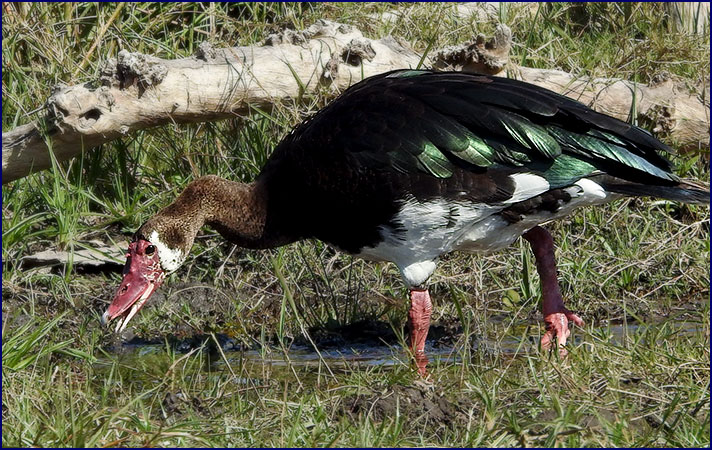
Spur-winged
goose |
A pair of juvenile saddle-billed storks stood nearby, tall
and handsome; they were full-sized, but their necks were still
covered in brown downy feathers. A red-billed francolin walked
through the grass followed by four half-grown chicks. We stopped
for a close-up view of a little bee-eater sitting on a twig. He
was vivid green with a yellow front, an orange throat, a black
stripe like a mask over his eyes, and brilliant sky-blue eye
shadow.
|
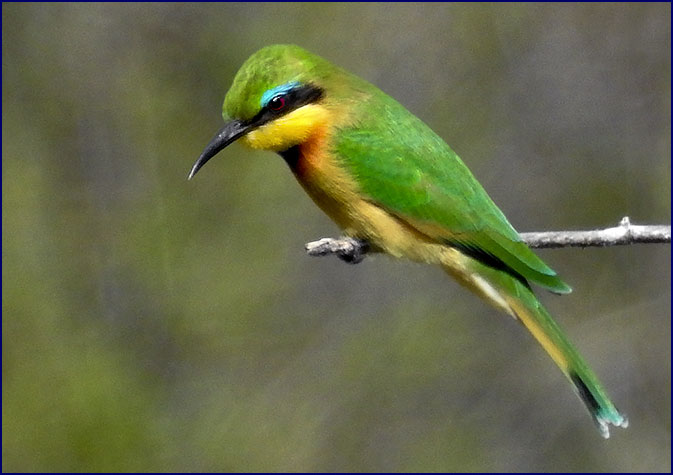
Little bee-eater |
We came to a large lagoon, and there were over a dozen
hippos in it. It was hard to tell if they were swimming, or
walking on the bottom. One of them lifted his head high out of the
water and opened his mouth wide, displaying huge dagger-like
teeth. The hippopotamus looks comical and somewhat improbable,
like a friendly character in a children’s story, but in reality
hippos are among the most dangerous animals in Africa. They are
territorial, and are especially aggressive if you get between them
and the water.
We noticed ghostly grey trunks of dead drowned trees
sticking up out of the water; Gee told us that until 2009 there
was no lagoon in this spot, and the road to Savuti went right
through it. But heavy rains came, the land changed and lagoons
formed, and now it is 3 to 4 meters deep.
|
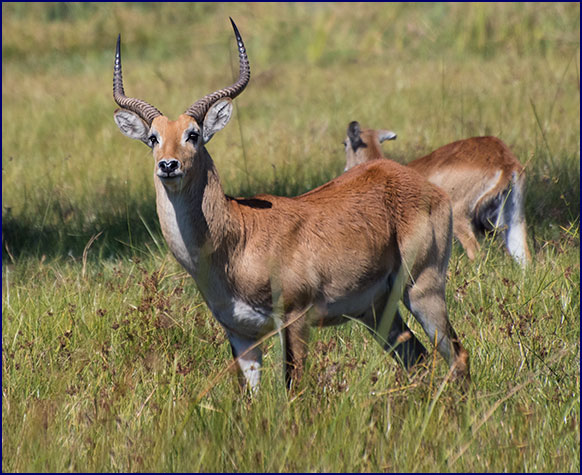
Red lechwe
|
A herd of about twenty red lechwe grazed near the lagoon;
this was our first chance to get really close to them. Their soft
coats are brilliant chestnut-red on their backs, fading gradually
to tan on their sides and white underneath. The bucks have long
gracefully curving, twisted horns and muscular necks. We saw one
young male with short little curving spikes that looked just like
devil’s horns.
We came to a beautiful marshy meadow with a blue river
serpentining through it. A fish eagle surveyed us from a treetop
and a darter stood with wings outstretched. A family of elephants
moved across the far side of the floodplain.
A baby hippo was grazing beside
the river, all alone. Gee told us it must be a boy; the mother
hippos have to hide the baby boys and feed them secretly, or the
father will kill them. This one was about two years old, and would
have been raised by himself all of his life. He would still be
nursing; the mother would keep coming to feed him until he is
three and a half. I felt sorry for him; he must have been
lonely.
The fish eagle took off from his tree, circling above us as
he searched for prey. He dived straight down into the marsh; we
couldn’t tell if he caught anything, but he soon flew up again.
With his dark body and white head and tail, he looked a lot like
our bald eagles, but when he dove we could see that the underside
of his wings were chestnut colored. His sharp talons were held
poised, ready to reach down and seize some unsuspecting fish. He
spiraled above us and then dove again, passing close, giving us
great in-flight photo ops. “My God, what a show!” Gee said. He
told us the eagles can see eight times as well as humans.
|
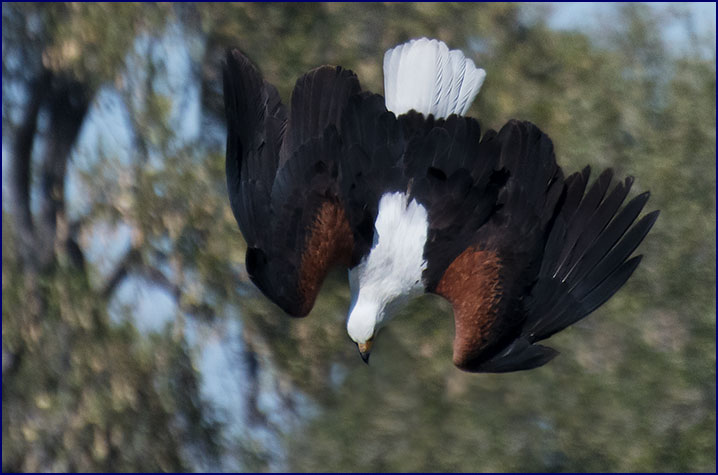
The
fish eagle in action, diving for a fish. |
A reed buck was standing by the river; he looked very
similar to the lechwe, but was a more uniform tan color, and was
not built downhill. He had a split in his ear, no doubt indicative
of some previous close call. Reed bucks have very loud alarm
calls, Gee said, and sharper horns than other antelopes. A bit
further on we saw his doe.
Gee picked some grass and gave us each a blade; he told us
it was spear grass, also known as magic grass. He said if you
moisten it and wait, it will point the way to the animal you want
to see. I tried it with poor results; it did not lead us to a
honey badger.
A pied kingfisher hovered above
the water, diving for fish. A red-billed fire finch scratched in
the grass, and a western great egret flew up the river.
Several crocodiles lay along the shore, shiny and sinister.
An open-billed stork stood quietly watching the proceedings; this
large black bird gets his name from the fact that his bill won’t
quite close all the way.
A lone elephant stood knee-deep in
the swamp by a bend in the river.
Several hadada ibises foraged along the stream; at first
glance they seem a rather drab grey-brown color, but when the sun
hits their backs they shine in iridescent tones of green and plum.
They are named for the loud Ha-Da-Da
cry they make when alarmed.
Gee told us that his tribe, the Bayei people, had lived in
this area in the past. The Zulu tribe came and tried to take it
over. The hadada ibises would give their raucous cry when they saw
the Zulu intruders, in effect serving as watchdogs. The Zulu did
not have mokoros, so the Bayei people prevailed, being better able
to travel through the waterways of the Delta.
There were three large hippos grazing in the floodplain,
not far from the river. They had some large nasty scars on them,
probably from fighting with each other. Gee told us that this was
the only time of year when you would see hippos out of the water,
presumably because the weather is cooler.
A tawny eagle sat in a dead
tree, scanning the floodplain. Suddenly he took off flying, coming
straight towards us; we got a dramatic up-close in-flight view of
the impressive raptor.
As we returned to camp, several vervet monkeys were
climbing high in the trees. A large male with light blue balls
moved effortlessly through the branches, appearing graceful and
dignified. Whenever I see monkeys in the wild I am struck by how
lovely they are; a completely different impression than given by
those in captivity.
When we came to lunch we were delighted to find a new
decoration; there were two glasses of water sitting on the table,
with three or four tiny fish swimming in each. Phillimon had
dipped them right out of the lagoon. Together with two porcupine
quills Phillimon had found and a seed pod that looked like a
little mokoro, it made an awesome centerpiece.
The guppies must have thought it a grand adventure; we
figured they were safer there in the glass where nothing was
trying to eat them!
We
relaxed a while after lunch, enjoying the quiet seclusion of the
campsite. The tent Jineen and I shared was just a few yards from
the lagoon. I walked around camp and took some photos, and we sat
in the camp chairs in front of the tents. Rob used the canvas
basin and tiny mirror in front of his tent to shave.
The elephants were back in the afternoon, about fifteen of
them, appearing out of the woods directly across the lagoon. We
watched them from the dining tent as they came down to drink and
play in the water. One large female had a small baby at her side,
one of the youngest we had seen - Gee said it was about two months
old. It was hard to get a good look, because the others all
surrounded it, shielded it from view. After a while the ellies
turned and left, several of them crossing the lagoon just to the
right of camp.
We hit the road again about three o'clock. Patty was
feeling much better; it turned out she had been having a reaction
to her malaria pills. We were glad she felt up to going on the
afternoon game drive. We stopped to photograph the camp from
across the water. The resident fish eagle flew up the river; we
watched as he circled above, and then landed in a tree. There was
a large nest on the branch below him. We sat and listened to him
calling out with his eerie mournful cry. A francolin came out of
the bushes and drank from a puddle, with four mottled golden-brown
chicks beside her, their reflection mirrored in the water.
|
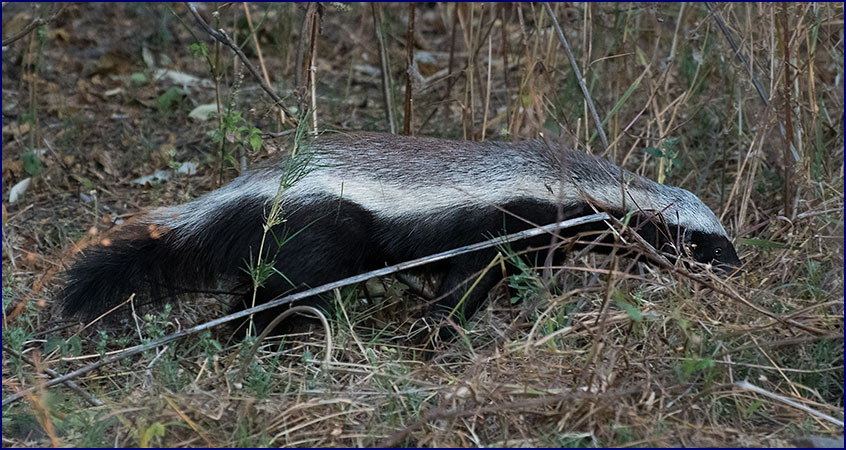
Honey badger
|
We were driving through a wooded area around four o'clock
when suddenly Tara called out, “Stop, back up! I saw
something.” She described it: “It has four legs, a silvery
back, and weighs about 20 pounds.” What could it be? Did I dare
hope . . ? Gee obligingly backed up, and sure enough, to my
delight it was a honey badger! He was hurrying along by the edge
of the woods, and then disappeared into the trees. Presently he
came out again, and we got a pretty good look at him before he
moseyed away. He was stocky and strong, black underneath with a
silver cape covering his back and the top of his head. He looked
like a cross between a skunk and a badger. Unbelievable! I had
wanted to see a honey badger ever since watching the movie The
Gods Must Be Crazy II, but I did not expect to ever get the
opportunity.
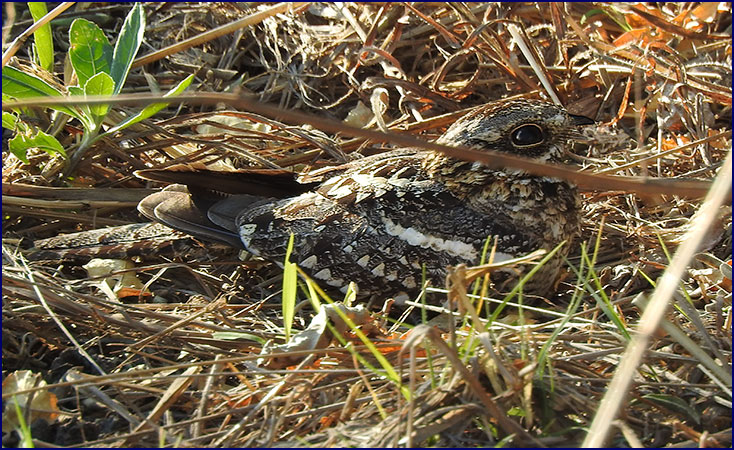
Fiery-necked
nightjar
|
Gee pointed out a beautiful little fiery-necked nightjar crouching well hidden in the grass; good spot! They are nocturnal,
so they hide during the day. It had mottled feathers and big eyes.
Gee told us its call sounds like it is saying good lord deliver us, good lord deliver us. It is incredible the way
he can spot tiny well-camouflaged birds and animals while driving.
We would not have seen a quarter as much without his expertise.
We came back out to the meadow, where a river wound through
a green marshy field. Elephants waded in the flooded grass. A grey
heron stood by the water, and a yellow-billed stork flew over.
Several crocodiles lazed along the river shore. They were
delightfully fresh-looking and attractive here by the river, quite
different from when they are covered in dried mud at a waterhole.
We got to see one of them quite close up; he had a serpentine
mouth with jagged lethal-looking teeth showing.
Crossing the water, we saw a swamp boubou by the riverbank;
a striking black and white bird that looked a bit like a coucal. A
jacana was wading in the shallows, admiring his reflection in the
water. A group of sacred ibis flew over us, white with black heads
and tails, their long curved beaks giving them a noble look.
There were hippos in the river, quite close to us. We could
get a close look at their faces above the water, with their
prominent eye sockets and tiny ears. One of them stood halfway up
out of the shallow water, creating a wave.
Leaving the river, we came to a large tree by an intersection in
the road. There were two giant eagle owls sitting in it. One
perched on a branch and looked around over its shoulder, the other
sat in the crotch of the tree with eyes squeezed tightly shut,
trying to sleep. They were magnificent.
|
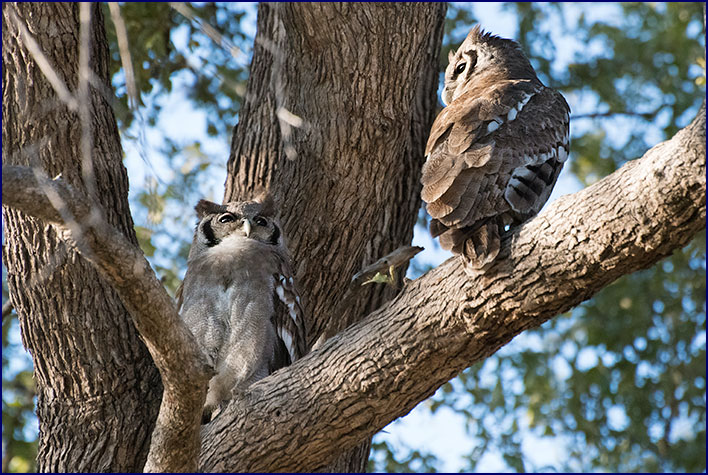
Giant eagle owls
|
A
herd of zebras meandered across the veld; one of the babies, still
in his fuzzy pajamas, stood on three legs and scratched his flank
with his teeth. We saw a large and particularly elegant zebra
stallion with dark shadow stripes. Before long the herd turned
their striped rumps toward us and moseyed away.
Gee got a radio report about lions, so he took off across
the veld, driving fast. As we bumped over an aardvark hole my
Coolpix camera went flying to the floor; I hoped it wasn’t
ruined.
We found the pride, or at least part of it. A lioness was
sleeping in the shade, and with her were three fairly small cubs,
still with spotted coats. There was another lioness nearby; she
was pale blonde, almost cream-colored, and she had one slightly
older cub. The male lion was sleeping behind some trees. Gee told
us the two mothers were sisters, and there are actually six
sisters in the pride.
|
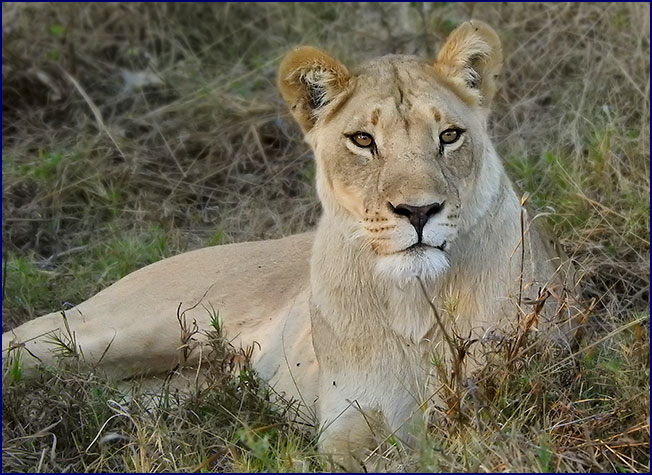
The cream-colored
lioness
|
The
cubs peered up at us curiously over mom’s back. Before long they
got up and started to play, wrestling with each other. One of them
pranced around carrying a stick proudly like it was a prized kill,
while the others tried to take it away from him. Then they would
pounce on each other again, scampering about and tussling in mock
battle, honing their skills for the future. Kittens are the same
the world over!
The pale blonde lioness got up and moved to a new spot,
then lay down on her back with her legs in the air. We could see
that her nipples were distended from nursing. Presently she sat up
again and looked around; she was exquisitely beautiful. The other
lioness came over to Blondie and rubbed faces with her, cheek to
cheek. She yawned and stretched expansively, then rubbed jowls
some more. It was incredibly tender and caring, and both lions
looked very content.
The older cub got up and wandered around, pausing to
sharpen his claws on a tree. Then he went over and rubbed faces
with the younger cubs, and they all played around a bit. The
smaller ones started wrestling with their mother, who
good-naturedly humored them.
We got our first good look at the
male lion as he came out from behind the trees. He got up and
yawned hugely, and then walked right up behind another safari
vehicle, looking as if he was considering getting in - maybe he
wanted to go for a ride? Then he lay down again, this time closer
and facing us. Something seemed a little odd about him but I
couldn’t pinpoint it; when I looked at my photos later I
realized that he was cross-eyed. Perhaps he was a descendant of
Clarence the Cross-eyed Lion from that old TV show, Daktari.
Gee
drove us to an open spot on the plain for Sundowners. We had a
glass of wine and some biltong (like beef jerky, but better), and
watched the sun go down. The acacia trees silhouetted against the
painted sky embodied the landscape we envision when we dream of
Africa. A thin crescent moon hung low in the sky, horizontal, like
a smile. We could hear the lions calling.
I noticed that my Coolpix camera was catching when I zoomed
the lens in and out; uh-oh, bad sign - getting thrown on the floor
of the Landcruiser had not been good for it.
Gee pulled out the spotlight and
we did a night drive on the way back to camp. The light caught the
gleam of eyes; it was a nightjar, this time up and walking along
the road instead of hiding; I was amazed at how long its legs
were. Gee also pointed out a thick-knee (which I thought was
rather a stupid name for a bird). As he swept the light back and
forth over the ground, we caught a glimpse of many small eyes
moving rapidly and bouncing up and down – springhares again!
We caught a glimpse of eyes
glowing up in the trees again; bushbabies no doubt, but we only
got a fleeting glance. I wondered, would an infant bushbaby be
called a bushbaby baby?
Gee stopped the vehicle and turned
off the engine, and we sat and just listened to the night sounds.
We heard the moaning roar of a lion in the distance; it is a
primal, soulful sound that reverberates through the night. It
leaves you feeling somehow part of all that is wild. Then there
was a whirr of wings and the blur of feathers, and a giant eagle
owl swooped down and caught a mouse, then flew away with his
prize.
Back in camp, we sat around the fire and reflected on what
a good day it had been for seeing baby animals; we had found baby
elephants, francolin chicks, lion cubs and wild dogs puppies.
|
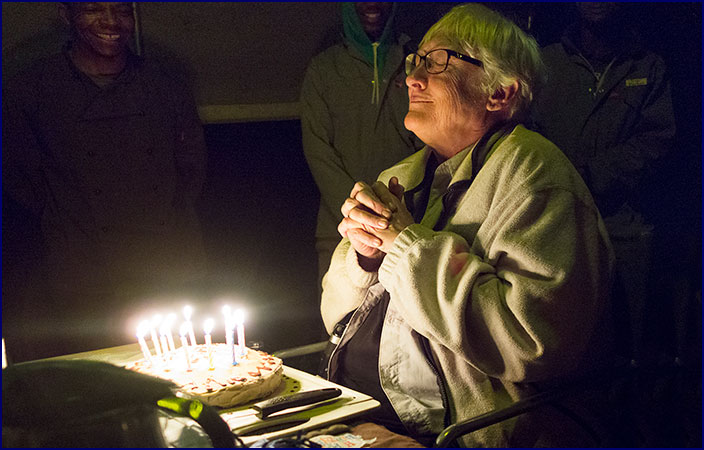
Patty makes a wish.
|
Pula came to the fire and
announced dinner, telling us what each course was. “And for
dessert, we will have G&Ts!” he finished. The reason for his
misdirection became evident after dinner; Pula had baked a
beautiful birthday cake for Patty. She blew out the candles (just
barely), and we shared the cake with the guys.
Phillimon set the fish free, pouring the centerpieces back
into the Okavango Delta.
|